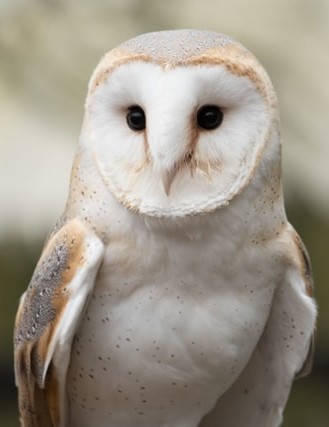Common Barn Owl
Tyto alba
Description
Barn owls have large round heads with white heart-shaped faces and dark eyes. Their wings and back are covered with buff-colored feathers. The feathers on their chests and underneath their wings are white with black or brown speckles. Their legs are long and featherless.
Size
Barn owls are slim medium-sized owls, measuring 14-20 inches long with a wingspan of 43-47 inches. Barn owls weigh 1-2 pounds.
Adaptations
- Barn owls fly in total silence due to their fringed feather tips that break the flow of the air at the trailing edge of their wings.
- Barn owls’ hooked beaks and sharp talons help them catch their prey, which they can locate in absolute darkness with the help of their exceptional hearing.
- One ear is placed higher on an owl’s head than the other, enabling the owl to sense the direction and distance of a sound.
- Like other owls, barn owls have excellent vision.
Diet
Mice, gophers, voles, shrews, small birds, insects, fish, and crustaceans make up the diet of the wild barn owl. At Cosley Zoo, the barn owls receive quail and mice. Because of their physical limitations, the raptors at Cosley Zoo are not fed live prey.
Reproduction
Barn owls mate for life. Females lay a clutch of three to six eggs. The eggs are laid one at a time every few days over two or three weeks. Since each egg needs to incubate for 32-34 days before hatching, the hatching of the eggs is also spread out over a two or three-week interval. At about three weeks of age, the owlets are able to eat the food their parents provide by themselves, without requiring the parents to tear it into pieces first. By two months of age, the young are completely independent. Barn owls raise two or three broods per year.
Shelter and Space Needs
Barn owls can be found in trees, abandoned burrows and buildings, and old farm machinery left in fields. Their preferred habitat is temperate forests and grasslands. Barn owls hunt at night in open areas and fields and cover a large area, sometimes flying up to three miles looking for food.
Life Expectancy
In the wild, barn owls have an average life expectancy of two years. In human care, they can live to be 15-18 years old.
Relationship With Man
Barn owls are at the top of the food chain and are considered important components of the ecosystem. They control the pest populations of small animals such as mice. While the barn owl was previously listed as Endangered in Illinois due to pesticide use and lack of suitable nesting locations, in 2015 its status was changed to Threatened. As of 2020, barn owls were no longer listed as Threatened and were completely removed from the Illinois List of Endangered and Threatened Species. This improvement was due in part to new nest boxes built and installed by volunteers.
Fun Facts
- Barn owls have a special toe called a pectinated claw that has ridges and is used for cleaning the birds’ feathers.
- Instead of the “hoot” associated with most owls, the barn owl makes a hissing noise.
- Owls don’t chew their food! They swallow it whole or in chunks and regurgitate a pellet containing bones, fur, feathers, and other material they are unable to digest.
- A baby owl is called an owlet.
- Barn owls have been called “nature’s perfect mousetrap” because of their large appetite. One barn owl family of two adults and six owlets can eat more than 1,000 rodents during a three-month period!






